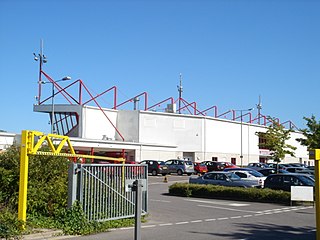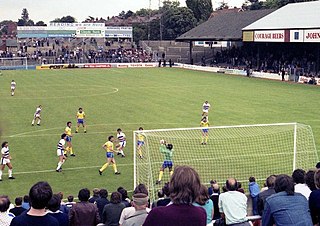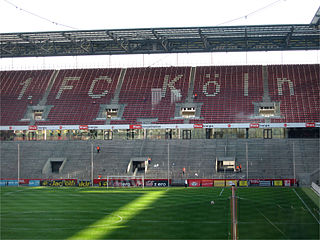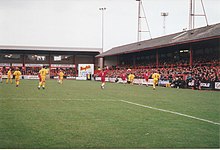
Crewe Alexandra Football Club is a professional association football club based in the town of Crewe, Cheshire, England. Its first team competes in League Two, the fourth level of the English football league system. Nicknamed 'The Railwaymen' because of the town's links with the rail industry, and also commonly known as 'The Alex', they have played at their current Gresty Road location since 1906. The supporters' fiercest rivalry is with Staffordshire-based side Port Vale.
The Hawthorns is an all-seater football stadium in West Bromwich, West Midlands, England, with a capacity of 26,688. It has been the home of Championship club West Bromwich Albion since 1900, when it became the sixth ground to be used by the club. The Hawthorns was the first Football League ground to be built in the 20th century, opening in September 1900 after construction work took only 4 months. The official record attendance at The Hawthorns stands at 64,815, set in 1937.

Stamford Bridge is a football stadium in Fulham, adjacent to the borough of Chelsea in West London. It is the home of only the men's Premier League Chelsea club, not the women's Chelsea club. With a capacity of 40,343, it is the ninth largest venue of the 2023–24 Premier League season and the eleventh largest football stadium in England.

Tannadice Park, usually referred to as Tannadice, is a football stadium in Dundee, Scotland. It is the home ground of Dundee United F.C., who have played at Tannadice since the club was founded as Dundee Hibernian in 1909. The stadium has been all-seated since 1994 and has a capacity of 14,223. It is located only 200 yards from Dundee F.C.'s stadium, Dens Park; the two are the closest senior football grounds in the UK.

Portman Road is a football stadium in Ipswich, Suffolk, England, which has been the home ground of the Premier League side Ipswich Town F.C. since 1884. The stadium has also hosted many England youth international matches, and one senior England friendly international match, against Croatia in 2003. It staged several other sporting events, including athletics meetings and international hockey matches, musical concerts and Christian events.

Home Park is a football stadium in Plymouth, England. The ground has been the home of EFL Championship club Plymouth Argyle since 1901.

St Andrew's, known for sponsorship reasons as St. Andrew's @ Knighthead Park, is an association football stadium in the Bordesley district of Birmingham, England. It has been the home ground of Birmingham City Football Club for more than a century. From 2018 to 2021, it was known as St Andrew's Trillion Trophy Stadium.

Newport Stadium, also known as Spytty Park, is an association football, rugby and athletics stadium in Newport, South Wales. It is the home of Newport City Football Club, Newport RFC and Newport Harriers Athletic Club. It was previously also used for home matches by Newport County and Albion Rovers football clubs. Newport County continue to use the stadium as a base for youth teams and senior squad training.

Turf Moor is an association football stadium in Burnley, Lancashire, England, which has been the home of Burnley Football Club since 1883. This unbroken service makes Turf Moor the second-longest continuously used ground in English professional football. The stadium is situated on Harry Potts Way, named after the manager who won the 1959–60 First Division with the club, and has a capacity of 21,944.

Priestfield Stadium is a football stadium in Gillingham, Kent. It has been the home of Gillingham Football Club since the club's formation in 1893, and was also the temporary home of Brighton & Hove Albion Football Club for two seasons during the 1990s. The stadium has also hosted women's and youth international football matches and a London Broncos rugby league match.
Mornflake is a British brand of oat and oat-based breakfast cereals launched in 1941 in Crewe, Cheshire.

Prenton Park is a large outdoor seated association football stadium in Birkenhead, England. It is the home ground of Tranmere Rovers The ground has had several rebuilds, with the most recent occurring in 1995 in response to the requirement of the Taylor Report to become all-seater. Today's stadium holds 16,587 in four stands: the Kop, the Johnny King Stand, the Main Stand and the Cowshed.
Whaddon Road, known as the Completely-Suzuki Stadium for sponsorship reasons, is a football stadium in Cheltenham, England. It is the home ground of Cheltenham Town F.C. It has a total capacity of 7,066, with a mixture of seating and terracing. The ground's official name was the Victory Sports Ground until April 2009 when it was renamed the Abbey Business Stadium through a sponsorship deal. It was announced on 13 July 2015 that the club had agreed a three-year deal to rename the stadium The World of Smile Stadium, but the deal ended after only one year and the stadium was renamed LCI Rail Stadium in 2016–17, before being named "Jonny-Rocks Stadium" in 2018–19, and "Completely-Suzuki Stadium" in 2022.

The Broadfield Stadium is a multi-purpose stadium in Crawley, West Sussex, England. It is currently used mostly for football matches and is the home ground of Crawley Town F.C. The stadium has a capacity of 6,134 people, and is owned by Crawley Borough Council.

Ochilview Park is a football stadium in Stenhousemuir in the Falkirk council area of Scotland. It is the home ground of Scottish League Two club Stenhousemuir. The stadium has a capacity of 3,746 with 626 seated.

Elm Park was a football stadium in the West Reading district of Reading, Berkshire, England. The stadium was the home of Reading Football Club from 1896 to 1998, when the club moved to the new Madejski Stadium.

A terrace or terracing in sporting terms refers to the standing area of a sports stadium, particularly in the United Kingdom and Republic of Ireland. It is a series of concrete steps, with intermittent safety barriers installed at specific locations to prevent an excessive movement of people down its slope.

Huish Athletic Ground, more commonly referred to as Huish, was a football stadium located in Yeovil, Somerset, England. It was the second home ground of Yeovil Town Football Club, after the Pen Mill Athletic Ground which they left in 1920, until the club's departure for Huish Park in 1990.
The Crewe Alexandra F.C. Academy is the player development centre of English Football League club Crewe Alexandra F.C. Set up by manager Dario Gradi in the late 1980s, it achieved official status as an FA Youth Academy in the late 1990s. By concentrating on developing its own players the club remained profitable by selling them on after they have gained experience with Crewe. The Academy is known to stress technical excellence, which accords with the aim to have the first team play attractive, passing football. Academy graduates include full England internationals Rob Jones, Danny Murphy, Seth Johnson and Dean Ashton and Wales international David Vaughan, plus the club's current manager and previous manager.
The Alexandra Recreation Ground, also known as Nantwich Road, was a multi-sport venue in Crewe in England. Opened in 1877, it was the home ground of Crewe Alexandra for 19 years, and also hosted an FA Cup semi-final and the 1886-87 Welsh Cup final, both in 1887, and an England home match in 1888.



















